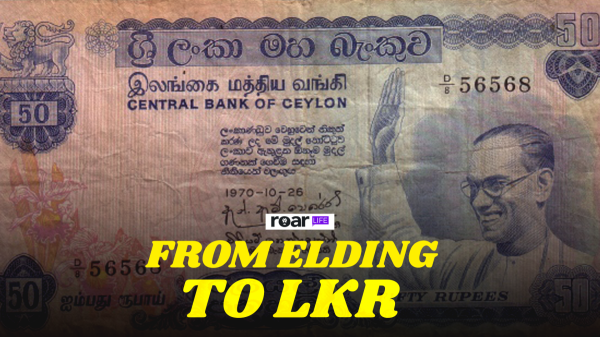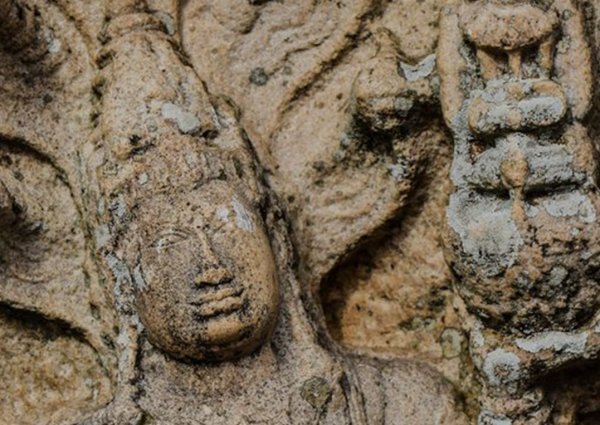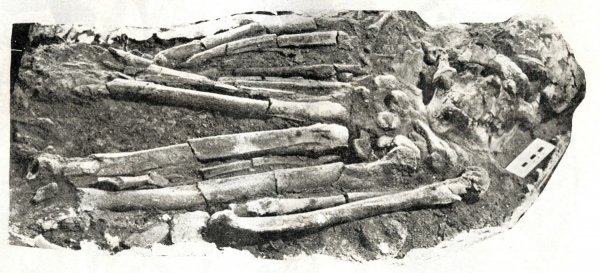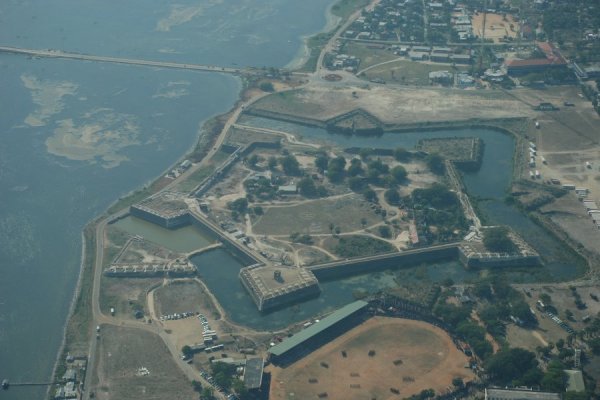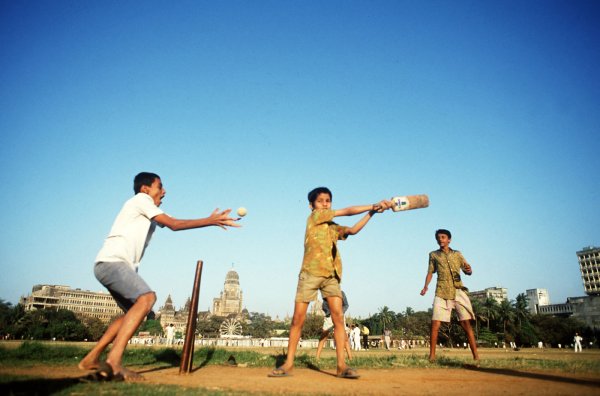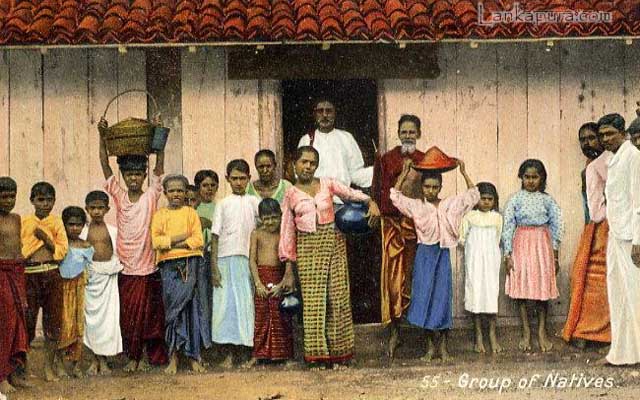
Sri Lankans had, and still have, some strange traditions that are thought of as indigenous. However, much of these have their origins in other parts of the world, especially in India, and, to a lesser extent, in the Middle East. Here are three such local beliefs and customs with exotic origins:
Dola-Duka (Pregnancy Craving)
Sri Lankans, and especially the Sinhalese, believe that mothers-to-be experience a longing to eat certain kinds of foods, and that if these cravings are not satisfied, it would harm her health or the child she is carrying. This is known as dola-duka.
Rural folk, in particular, believe that if the expectant mother’s dola-duka cravings are not sated, she would become weak and emaciated. What’s more, the foetus would get angry and might even turn out to be deformed, so it is extremely important that her gastronomic desires be satisfied. That’s not all; these folk infer the sex of the unborn child by the longings of its mother. Thus, if the expectant mother shows an unusual craving for acid foods, it is a sign that she would give birth to a daughter. If she shows a strong liking for sweet foods, it is a sign that she would give birth to a son (Panam Pattuve Jana Adahili Ha Janavishvasa, Gunasekara Gunasoma, 1994).
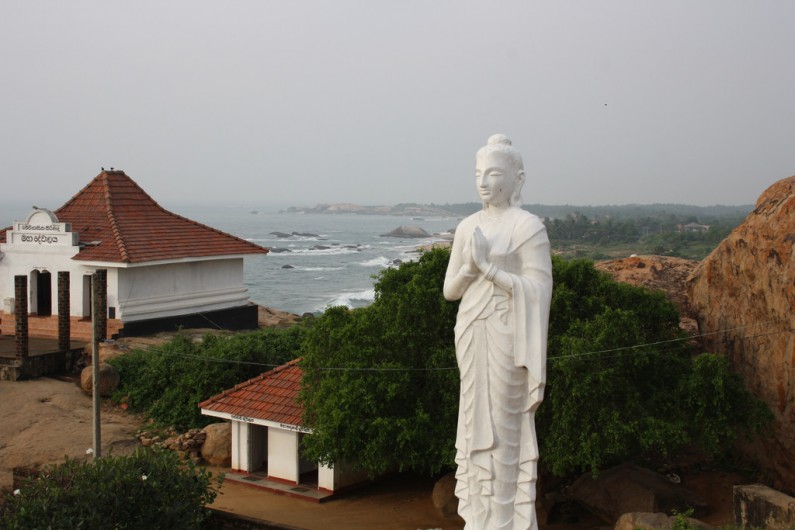
A statute of Queen Viharamahadevi, who, as the tale goes, had a very strange case of dola duka when expecting future King Dutugemunu. Image credit: flickr/Ajay Kamalakaran
This is, in fact, a very old belief. In the ancient chronicle of Sinhalese royalty, the Mahavamsa, we read of Queen Viharamahadevi, who lived around the 2nd century BC, experiencing some unusual pregnancy longings (dohala) when she was expecting Prince Dutugemunu. The chronicle has it that the queen longed to lie on her right side in a beautiful bed with a very large honeycomb and to partake of honey after giving it to twelve thousand bhikkhus. She also craved to drink, while trampling his very head, the water in which was washed the sword that beheaded the chief warrior among Elara’s soldiers. Needless to say, her husband, King Kakavanna Tissa, made sure that the longings of the queen were somehow satisfied.
This hoary old belief seems to have an Indian origin. Ancient Hindu treatises, such as the Yajnavalkya Smrti, declare that if the wishes of the expectant mother are not met, the foetus would become unhealthy, that it may be deformed, or that the mother would suffer a miscarriage. The Sinhala term dola-duka used to describe it likewise seems to derive from an ancient Aryan usage once widespread in northern India.
A linguistic examination of the term dola sheds some light on this. The term duka, which is suffixed to it, merely means ‘suffering’ or ‘desire,’ excessive desire being equal to suffering in the Buddhist worldview. So one can understand why it was used to describe the pregnancy longings we are discussing here. However, the key word here is dola which derives from the Old Indo-Aryan usage dvihrda, meaning ‘two hearts:’ in other words the hearts of mother and her unborn child. As H. Lueders has shown in his paper Zwei Indische Etymologien (published in Philologica Indica, 1940), the Prakritic dohala (which is interestingly the very word the Pali Mahavamsa uses to describe queen Viharamahadevi’s pregnancy cravings) arose from the Sanskritic dvaihrda (literally meaning ‘two hearts’) due to the fact that the expectant mother was considered to have two hearts, hers and that of her foetus. This is lent support by Sushruta, the author of the great Samhita (a well-known medical treatise in Sanskrit) who alludes to a pregnant woman as one with two hearts (dvihrdayam).
Thus, we may suppose that the idea of pregnancy craving originally arose in India and that the term dola (-duka) originally meant ‘(the desire of) two hearts’. The underlying belief here seems to have been that the unborn child’s desires were manifested in the longing for certain foods on the part of its mother, and that these had to be satisfied to ensure the wellbeing of the child.
Isa Diya Mangalya (Virginity Testing)
Conservative Sri Lankans are still known to practice a rather bizarre custom that would today have many up in arms. This is virginity testing, where the newly wed bride is subjected to an examination to determine whether she had been a virgin at the time of her marriage. The practice is known by many names. It is called Isadiya Mangalya (literally meaning Head-Water Ceremony), in certain parts of the country as Isa Diya Balanta Yaema (Lit. Going to See the Head Water), or more simply as Balanta Yaema (Going to See).
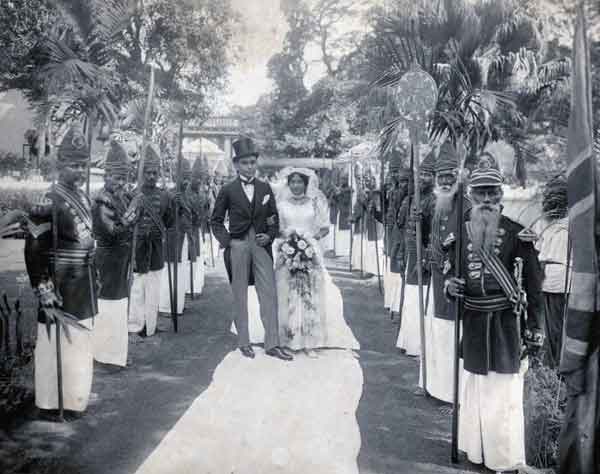
An old photograph of a Sri Lankan wedding. Virginity testing was a common wedding custom. Image courtesy karava.org
To this day, it is the custom in traditional Sinhalese families to provide the newly married couple with a white cloth known as kirikadahelaya, upon which they are expected to lie during their first intercourse on the wedding night. The groom’s mother, or some elderly women, or, in certain areas, the washerwoman, would examine the cloth for blood stains that would have presumably flowed from the rupture of the bride’s hymen. The occurrence of blood stains on the sheet would be taken as evidence that the bride had indeed been a virgin. On the other hand, the absence of blood is looked at with askance, as it indicates that the bride had indulged in premarital sex. If all is well, the groom’s mother would beat a rabana (drum), and give the girl’s brother red flowers wrapped in betel leaves, which he hands over to his mother, who would then beat a drum, informing the village all is well. If proof of virginity is lacking, the rabana is not beaten, and white flowers would be sent to the girl’s mother (Cultural Rhapsody: Ceremonial food and Rituals of Sri Lanka, Vinodini De Silva, 2000).
The practice is so prevalent in local society, both among the Sinhalese and the Muslim Moors, that one would think that it is a very ancient practice that originated with the ancestors of the Sinhalese, and that the Moors adopted it from their Sinhalese neighbours. But there’s a hitch here. The Sinhalese of old, unlike those of today, do not seem to have ever cared if a woman was a virgin or not. Even a writer as observant as Robert Knox did not notice the custom among the Kandyan Sinhalese of his time. In contrast, he wrote in his Historical Relation of the Island Ceylon (published in 1681) that:
“They do not matter or regard whether their Wives at the first Marriage be Maids or not.”
This leads us to turn the searchlight elsewhere; and where else to focus on but on the immediate neighbours of the Sinhalese: the Moors, who trace their origins to Arabian forbears who espoused local women?
The Moors, like their Sinhalese neighbours, have traditionally had a virginity test involving hymenal blood. Although repugnant to Islamic ideals of propriety, the practice still continues in the urban as well as the rural areas. A research study on local Muslim women, Between Two Worlds, published by the Muslim Women’s Research and Action Forum in 1999, found that a ‘virginity test,’ similar to that of the Sinhalese, was being practiced amongst the Muslims.
“The bride is given a white cloth to be used on the wedding bed. The couple usually spend their wedding night at the bride’s home and the day after the wedding, elders from the groom’s family visit the bride’s home for breakfast. In Colombo, we came across a custom where a red flower and turmeric is sent to the bridegroom’s house if the bride is a virgin. Here as in the other areas including Amparai the bride is given a gold sovereign (or jewellery) by the bridegroom as an appreciation for her virginity after consummation of the marriage.”
As such, could it be possible that the Sinhalese had indeed borrowed the custom from the ancestors of the Moors? European travellers of old have reported for centuries past of the bloodstained cloth of the wedding night being carried through the streets to the house of the bride’s parents with drumming and shouts of joy in Morocco, Turkey and the lower classes in Cairo (Encyclopedia of Islam, 1934). Surprisingly, it is even alluded to in the Alf Layla Wa Layla (Arabian Nights), where, in the tale of the negro Sawwab, we have a reference to the mother of a girl who had lost her virginity staining the bride’s chemise with pigeon’s blood and having it carried among all the female guests, so that they might believe in her daughter’s virginity. Whether this was a common practice is doubtful. Nevertheless, it was known among the Arabs of yore.
It is possible that this is an ancient Semitic practice, since it was known among the ancient Jews, who, like the Arabs, are Semites descended from Abraham. The ‘tokens of virginity’ mentioned in the Old Testament (Deuteronomy) referred to exactly the same thing – the cloth or bed linen stained with the blood from the rupture of the bride’s hymen. That it should have survived the influence of Islam, which speaks so much against divulging the secrets of the nuptial bed, shows how pervasive it must have been.
Eka Ge Kaema (Fraternal Polyandry)
In the olden days, and well until colonial times, the Sinhalese of certain areas indulged in a rather unusual custom that would have flown in the face of everything modern day wife swappers stand for. This was the practice of fraternal polyandry – in simpler terms, several brothers sharing one wife. The practice, euphemistically referred to as Eka-Ge-Kaema, or ‘Eating in One House,’ is no longer legal, though it is possible that it may still be surviving in some remote areas.
The practice was fairly common in the olden days. Even royalty engaged in it on occasion. In the Magul Maha Vihara slab inscription of Viharamahadevi (C.14th century), we find the queen calling herself the chief consort of the two brother kings named Perakumba (Perakumba De-Bae-Raja-Daruvan De-Denata Aga Mehesun Vu Vihara-Maha-Devi). The queen referred to in the epigraph is a lesser-known namesake of the more famous queen of the 2nd century BC, who was mother to the Sinhalese national hero Dutugemunu, while the brother kings were evidently two petty kings who wielded independent authority in the Southern Ruhuna country at the time.
The practice gained more popularity in the days of the Kandyan Kingdom due to certain practical reasons. For one thing, it minimised the fragmentation of ancestral property, since if each brother married separately, there would be more heirs to inherit. For another, the feudal setup of the Kandyan Kingdom required adult males to perform mandatory state duty (Rajakariya), including military service, which meant that they had to be away from home, sometimes for months. The arrangement allowed the remaining brother or brothers to take care of the joint-wife and children, who would have otherwise been left unprovided for.
The English traveller Robert Knox observed in his well-known work on the Kandyan Kingdom Historical Relation of the Island Ceylon (1681): “
“In this country each man, even the greatest, hath but one wife; but a woman often has two husbands. For it is lawful and common with them for two brothers to keep house together with one wife, and the children do acknowledge and call both fathers.”
The practice obviously shocked the colonial rulers. The Dutch clergyman, Philippus Baldaeus, noted in his Beschrijvinge der Oost-Indische Kusten (1672) that the Sinhalese recommend the conjugal duty to be performed by their own brothers, and cites the case of a woman resident in Galle who had “confidence enough to complain of the want of duty in her husband’s brother on that account.”
The British colonial regime made polygamy, both polygyny and polyandry, illegal in 1859, but the practice persisted nevertheless. Ponnambalam Arunachalam noted in his contribution on ‘Population’ to the Twentieth Century Impressions of Ceylon (1907):
“Polyandry, though illegal, continues to exist among the Kandyan peasantry, especially in the case of brothers. The law against polyandry is evaded by not registering the union at all or by registering it as with one brother only. In all cases the ceremonies of marriage are performed with one brother only.”
As to how the practice came into being, it is possible that it may have been borrowed from certain peoples of India, though it could have also been an independent development over time due to the exigencies of a feudal society. The practice was known to exist among other South Asian peoples such as the folk of Tibet and Sikkim, the Jats of North India, and the Nayars of South India, until fairly recent times. The largest population practicing polyandry was to be found among largely non-Aryan peoples of the North Western Himalayas, which, in India, covers Ladakh and the northern fringe of Himachal Pradesh, where brothers were known to share a wife or wives in common.
The practice seems to have been foreign to the Vedic Aryans, nor is it contemplated in the Smrtis. The only instance of polyandry in ancient Hindu literature is the story of Draupadi, who was married to the five Pandava brothers, which occurs in the Indian epic Mahabharata. Draupadi’s polyandrous marriage may well have been a historical event, for if it were not so, the author of the epic, who is at his wit’s end to justify it, would have quietly kept silent over it.
Dr. A. S. Altekar, in his fascinating work The Position of Women in Hindu Civilization (1938), has advanced an interesting theory to explain its occurrence among the Pandavas. Observing that polyandry was still current to some extent among a few non-Aryan tribes of Kashmir and Tibet, he notes that it is probable that the Pandavas were following a custom which they may have borrowed from either of these provinces. He notes that this would suggest that they belonged to a stock of Aryans different from that of the Kauravas and that they entered India via the Gilgit Pass in Kashmir or through Nepal.
Altekar’s observations are interesting, given that there is evidence to show that a branch of the Pandavas, the Pandyas, also settled in South India, establishing the town of Madura after its more famous namesake in the north, Mathura. Especially relevant to our discussion is the fact that the founding fathers of the Sinhalese, according to the Mahavamsa, took wives from among the Pandyas. Thus, it is possible that polyandry among the Sinhalese might have originated from folk originating in the Pandya country of South India, who in turn had originated from the Pandavas of North India.
Alternatively, it could have originated, or, at any rate, become more popular, due to the growing influence of the Nayar and other military castes of Kerala, who served the local kings as mercenaries. Caesar Fredericke, who travelled to the Malabar area in 1563, observed that the Nayar had their wives common among themselves, and that when any of them go into the house of any of these women, he leaves his sword at the door, and the time that he is there, there is none who would dare come into that house (The Voyage and Travels of M. Caesar Fredericke, Merchant of Venice, translated by Thomas Hickoke, 1598). This was somewhat similar to the local Kandyan custom of leaving the amude (loincloth) at the door when one brother was with the common wife (Folklore of Sri Lanka, Nandadena Ratnapala, 1991). It is a well-known fact that Kerala mercenaries served the local kings. The Elunuttuvar (The Seven Hundred) were one such military organisation from Kerala, who arrived here very likely during the Perumal period (10th-12th centuries) or shortly afterwards. Thus it is quite possible that mercenaries from Kerala introduced ‒ or at any rate popularised ‒ the practice here.
What we can see from all this is that even our customs and beliefs do not necessarily have to originate among ourselves. They could be borrowed and embellished over time so that they become part of our cultural baggage, which we regard as our own. At the end of the day, nothing is really ours except perhaps our genes. All else is a play with givers and takers playing their role in the drama of life.
Featured image courtesy lankapura.com
